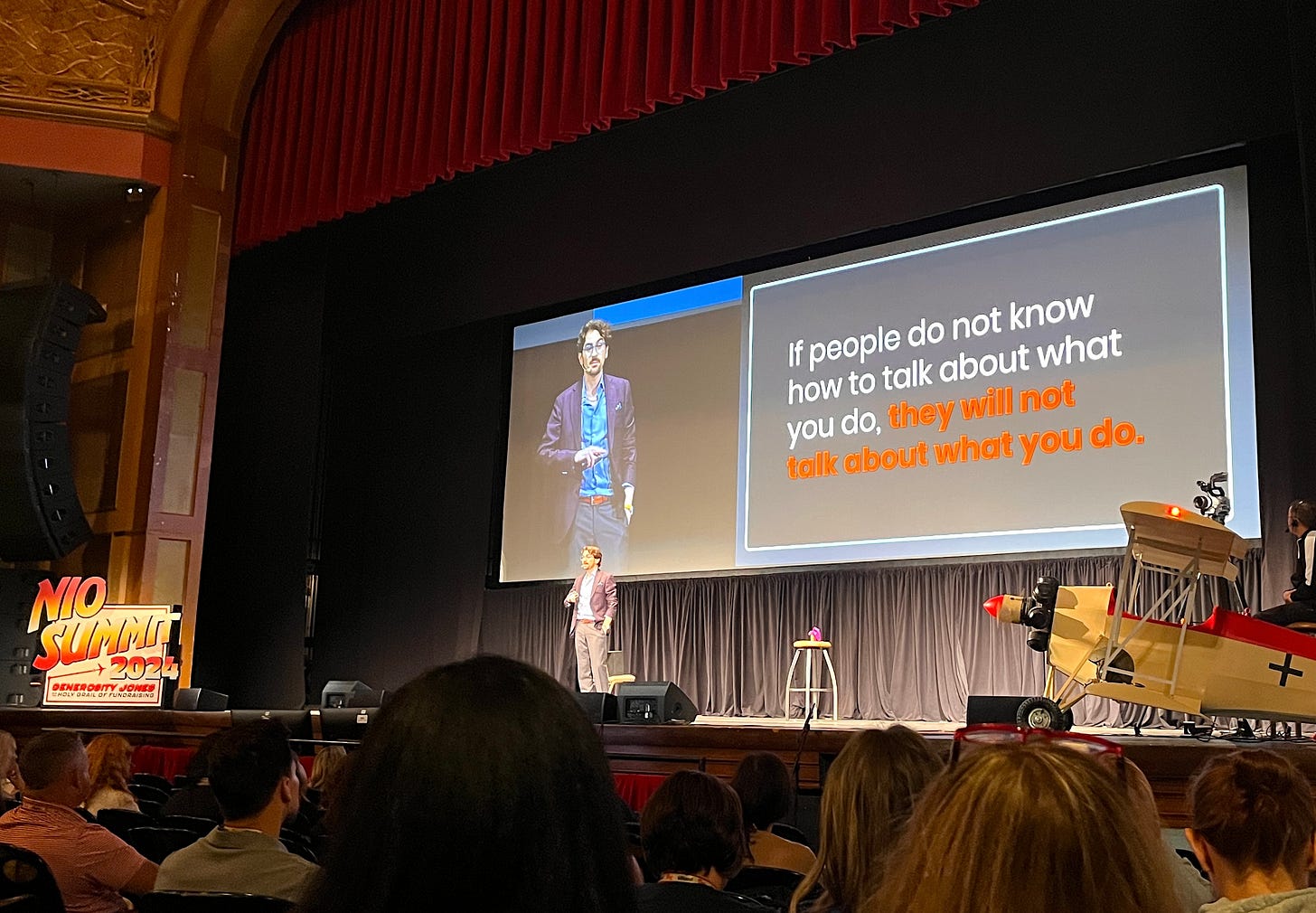Tell stories, demand donor partnerships & communicate your budget.
Three weekly insights to get funding
Sawasdee khap
I write this newsletter from Thailand. My co-founder Kathleen and I are leading a theory of change workshop with a health NGO working in Myanmar.
And after being in 10 different countries over the last year, I'm reminded of this powerful quote:
“The more I travel, the less I know.”
— Kevin
💪🏽💛
Three insights
1. Numbers tell. Stories sell.
People aren’t calculators. They’re storytellers.
That’s why in fundraising:
Data wrapped in a story is 22x more memorable. Let me share a quick example.
Bryan Stevenson — founder of Equal Justice Initiative — earned the longest standing ovation in TED Talks history. He spoke about a complex topic (the criminal justice system) and raised $1 million that night.
How?
He told stories for 65% of his presentation.
In fact, he spoke for minutes before introducing a single statistic about U.S. prisons.
“You need data, facts, and analysis to challenge people, but you also need narrative to get people comfortable enough to care about the community that you are advocating for,” says Stevenson.
So remember:
Donors want a story they can remember.
Not a fact to memorize.
Of course, your impact metrics matter too. But always wrap it in storytelling.
Speak in totals and tales.
Paint pie charts and pictures.
Shape spreadsheets and sagas.
2. Donor partners collaborate, not dictate.
Many funders claim you’re a partner.
Most of you feel like a grantee.
And this messy donor/doer dynamic leads to a lot of tension, misaligned expectations, and damage in our sector.
Let’s dig in. ⤵
“Although foundation language is about shared values and partnerships, foundation behavior (and grantee behavior) reflects the underlying business relationship,” says Jan Masaoka.
“Foundations still overwhelmingly make single-year, project grants… exactly how one hires a vendor, and the exact opposite of how one works in a partnership.”
Bullseye. 🎯
Just 52% of nonprofits believe foundations are even aware of their challenges. And only a third think funders help them address these challenges, according to the Center for Effective Philanthropy.
The word partnership generally means:
Being engaged in the same activity
Having shared incentives
Two-way feedback
So it’s not a partnership when a foundation only wires money and visits every few years, or when a donor’s endowment keeps growing but the nonprofit grant does not, or when a funder doesn’t welcome criticism about its own work.
What’s the harm?
First, pretending to be a partner wastes the nonprofit’s fundraising time.
Second, imitation partnerships mask our sector’s all-too-common donor-driven systems.
And third, funders that overly control a collaboration can negatively impact the communities we serve.
Look, funder friends.
I’m all for the much-needed balancing of power. And some of our favorite foundations go beyond the grant to do partnerships well.
But messaging matters.
So if partnership isn’t your thing, all good. Just stop disingenuously branding your grantees as partners without the actions to back it up.
Instead, follow MacKenzie Scott’s lead — give hassle-free money and call them gifts.
“Sometimes the best thing we donors can do to advance social justice is to just write the check and get out of the way,” says Vu Le.
Partnerships should propel.
Not just pledge.
3. A budget is a fundraiser.
Budgets help you raise money, not just spend it.
And financials are part of your messaging too.
Because “a well-communicated budget is a fundraising tool,” says Robin Bruce at Dovetail Impact Foundation. That’s why our brand training with Dovetail grantees now includes a financial module.
Here are six budgeting ideas for your brand:
Align the budget with your theory of change: tell how your expenses are necessary for the mission and vision.
Connect budgets to success stories: link budget elements to positive outcomes to make the financial narrative compelling.
Turn budget challenges into appeals: share budget constraints that motivate donors to contribute towards overcoming these shortfalls.
Use budget comparisons for impact: compare past and present budgets to demonstrate growth and increased impact over time.
Design visuals for budget line items: employ visual aids like infographics to make complex financial data more engaging.
Educate donors on the need for overhead: break the overhead myth and never perpetuate the dangerous 100% model.
They say a budget is a moral document.
Meaning, “it tells us, mathematically, what areas, issues, things, or people are most important to the creators of that budget, and which are least important,” says Jim Wallis.
So dare to think about budgeting differently.
It isn’t just numbers.
It’s a fundraising narrative.
The weekly bonus
A great reminder from messaging expert Brian Miller:
He and I both spoke at the NIO Summit back in September.
You can watch my keynote talk here and hire me to speak at your next event.
Need my help?
If this advice is useful — but you’re ready to get even more fundable and findable — check out Brand Bootcamp.
It’s our self-paced, online course to maximize your funding. In just 15 minutes a day.
P.S.
Doing deep, introspective brand work can make you feel like you’re seeing your nonprofit for the first time.







